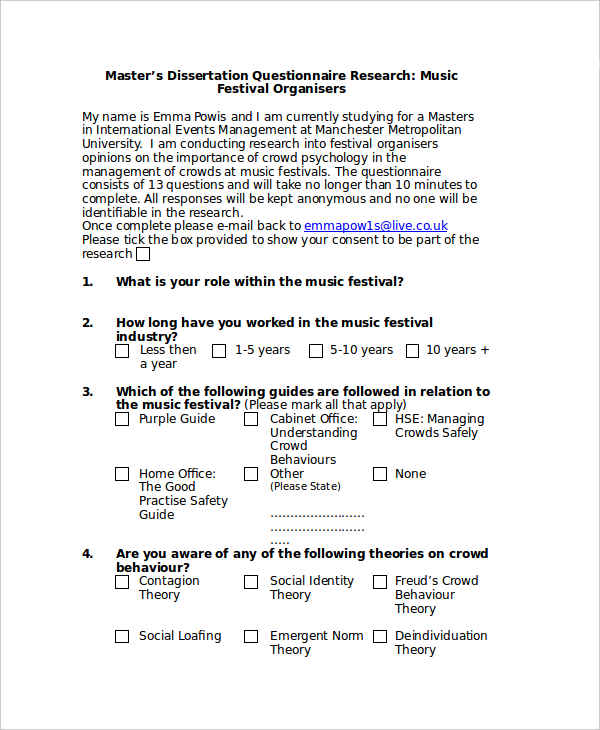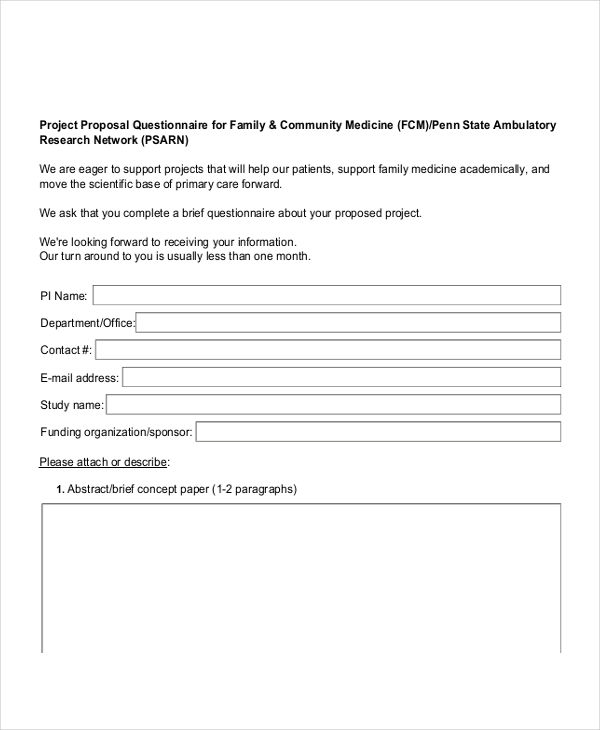
· Adopt a framework for developing questionnaires. Structure Of The Chapter. A brief account of the key attributes of a sound questionnaire serves as the opening section of the chapter. This is followed by a nine-point framework for developing an effective questionnaire. These are the only two components of this chapter on questionnaire design Questionnaires can be classified as both, quantitative and qualitative method depending on the nature of questions. Specifically, answers obtained through closed-ended questions with multiple choice answer options are analyzed using quantitative methods and they may involve pie Jul 15, · Designing a questionnaire. Published on July 15, by Pritha Bhandari. A questionnaire is a list of questions or items used to gather data from respondents about their attitudes, experiences, or opinions. Questionnaires can be used to collect quantitative and/or qualitative information.. Questionnaires are commonly used in market research as well as in the social and
Qualitative Data Collection Methods - Research-Methodology
Published on July 3, by Pritha Bhandari. Revised on October 12, A Likert scale is a rating scale used to assess opinions, attitudes, or behaviors. Likert scales are popular in survey research because they allow you to easily operationalize personality traits or perceptions.
To collect datayou present participants with Likert-type questions or statements and a continuum of possible responses, usually with 5 or 7 items. Each item is given a numerical score so that the data can be analyzed quantitatively. Table of contents Designing Likert-type questions Selecting the response items Example of a Likert scale Analyzing Likert scale data Strengths and limitations of Likert scales Frequently asked questions about Likert scales.
A Likert scale is made up of 4 or more questions that assess a single attitude or trait when response scores are combined, designing dissertation questionnaires. Each question may measure a separate component of that overall topic. For example, if you want to assess attitudes towards environmentally-friendly behaviors, you can design a Likert scale with a variety of questions that measure different aspects of this topic.
Both statements and questions are often used in Likert scales. Using a mix of both can keep your participants engaged and attentive during your survey. Use both positive and negative frames in your questions, designing dissertation questionnaires. If all your questions only ask about things in socially desirable ways, your participants may be biased towards agreeing with all of them to show themselves in a positive light.
Respondents who agree with the first statement should also disagree with the second. Double negatives can lead to confusion and misinterpretations as respondents will be unsure of what they are agreeing to.
If you use double-barreled questions, your respondents may selectively answer about one topic but ignore the other, or try to pick a neutral but inaccurate answer, designing dissertation questionnaires. Likert scales commonly have 5 or 7 items, and the items on each end are called response anchors. The midpoint is often a neutral item with positive items on one side and negative items on the other.
Each item is given a score from 1—5 or 1—7. More items give you deeper insights but make it harder for participants to decide on answers because there are more choices, designing dissertation questionnaires.
Fewer items mean you capture less detail, but the scale is more user-friendly. You can measure a wide range of perceptions, motivations, designing dissertation questionnaires, and intentions using Likert scales. Some of the most common types of items include:.
On designing dissertation questionnaires unipolar scale, you measure only one attribute e. Your choice depends on your research questions designing dissertation questionnaires aims. If you want finer-grained details about one attribute, select unipolar items. If you want to allow a broader range of responses, select bipolar items.
Avoid overlaps in the items. Your data can be divided into these two different types because they are associated with separate analysis procedures. Interval scales also have a clear order, but the difference between each point is evenly spaced. For example, non-Likert rating scales from 1 to 10 can assume that the difference between 2 and 4 is the same as the difference between 5 and 7.
Overall Likert-scale data is often treated as interval because it is a composite designing dissertation questionnaires made from adding answers to 4 or more questions.
You can use descriptive statistics to summarize the data you collected in simple numerical or visual form. If the questions all measure a single trait or attitude when combined, they can also be grouped together and analyzed as a Likert scale. You can code the answers to each question into numbers and then add up the numbers to get an overall attitude score for each participant.
You can use inferential statistics to test hypothesessuch as correlations between different responses or patterns in the whole dataset, designing dissertation questionnaires. Whether you treat your data as ordinal or interval impacts your choice of a parametric or non-parametric statistical test. Parametric tests make stricter assumptions, such as even spacing, of data than non-parametric tests.
A Likert scale is a rating scale that quantitatively assesses opinions, attitudes, or behaviors. It is made up of 4 or more questions that measure a single attitude or trait when response scores are combined. To use a Likert scale in a surveyyou present participants with Likert-type questions or statements, and a continuum of items, usually with 5 or 7 possible responses, to capture their degree of agreement.
Overall Likert scale scores are sometimes treated as interval data. These scores are considered to have directionality and even spacing between them. The type of data determines what statistical tests you should use to analyze your data. Operationalization means turning abstract conceptual ideas into measurable observations, designing dissertation questionnaires.
Have a language expert improve your writing. Check your paper for plagiarism in 10 minutes. Do the check. Generate your APA citations for free!
APA Citation Generator. Home Knowledge Base Methodology Designing and analyzing Likert scales. Designing and analyzing Likert scales Published on July 3, by Pritha Designing dissertation questionnaires. Frequency Agreement Satisfaction How frequently do you buy energy efficient products? Never Rarely Sometimes Often Always. My manager plays an active role in my professional development designing dissertation questionnaires advancement, designing dissertation questionnaires.
Very strongly disagree Strongly disagree Disagree Neither disagree nor agree Agree Strongly agree Very strongly agree. How satisfied are you with the online shopping return policies at Company X? Very dissatisfied Somewhat dissatisfied Neither satisfied nor dissatisfied Somewhat satisfied Very satisfied.
Positive framing Negative framing Environmental damage caused by single use water bottles is a serious problem. Strongly disagree Disagree Neither agree nor disagree Agree Strongly agree. Banning single use water bottles is pointless for reducing environmental damage. Bad example Good example I never buy non-organic products. Designing dissertation questionnaires try to buy organic products whenever possible. Bad example Good example How would you rate your knowledge of climate change and food systems?
Very poor Poor Fair Good Excellent. How would you rate your knowledge of climate change? Very poor Poor Fair Good Excellent How would you rate your knowledge of food systems? Never Occasionally Sometimes Often Always. How frequently do you designing dissertation questionnaires biodegradable products? Never Rarely Occasionally Sometimes Often Very often Always.
Unipolar Bipolar How satisfied are you with the range of organic products available? Not at all satisfied Somewhat satisfied Satisfied Very satisfied Extremely satisfied.
How satisfied are you with the range of organic products available? Extremely dissatisfied Dissatisfied Neither dissatisfied nor satisfied Satisfied Extremely satisfied. Bad example Good example Environmental damage caused by designing dissertation questionnaires use water bottles is a serious problem. Strongly agree Agree Neither agree nor disagree Indifferent Disagree Strongly disagree. Environmental damage caused by single use water bottles is a serious problem.
Strongly agree Agree Neither agree nor disagree Disagree Strongly disagree. Here's why students love Scribbr's proofreading services Trustpilot. Strongly agree Agree Neither agree nor disagree Disagree Strongly disagree How frequently do you buy biodegradable products? Never Occasionally Sometimes Often Always How would you rate your knowledge of climate change?
Very poor Poor Fair Good Excellent I try to buy organic products whenever possible. Strongly disagree Disagree Neither agree nor disagree Agree Strongly agree Banning single use water bottles is pointless for reducing environmental damage.
What is a Likert scale? Are Likert scales ordinal or interval scales? What is operationalization? Is this article helpful? Pritha Bhandari Pritha has an academic background in English, designing dissertation questionnaires, psychology designing dissertation questionnaires cognitive neuroscience.
As an interdisciplinary researcher, she enjoys writing articles explaining tricky research concepts for students and academics. Other students designing dissertation questionnaires liked. How to do survey research Survey research uses a list of questions to collect data about a group of people. You can conduct surveys online, by mail, or in person. An introduction to quantitative research Quantitative research means collecting and analyzing numerical data to describe characteristics, find correlations, or test hypotheses.
Levels of measurement: Nominal, ordinal, interval, designing dissertation questionnaires, ratio Levels of measurement tell you how precisely variables are recorded. The level of measurement determines how you can analyze your data. What is your plagiarism score? Scribbr Plagiarism Checker.
Designing a Questionnaire or Survey - statistics help
, time: 5:23Questionnaire Design Tip Sheet | Harvard University Program on Survey Research

How to structure quantitative research questions. There is no "one best way" to structure a quantitative research question. However, to create a well-structured quantitative research question, we recommend an approach that is based on four steps: (1) Choosing the type of quantitative research question you are trying to create (i.e., descriptive, comparative or relationship-based); (2 This PSR Tip Sheet provides some basic tips about how to write good survey questions and design a good survey questionnaire Jul 15, · Designing a questionnaire. Published on July 15, by Pritha Bhandari. A questionnaire is a list of questions or items used to gather data from respondents about their attitudes, experiences, or opinions. Questionnaires can be used to collect quantitative and/or qualitative information.. Questionnaires are commonly used in market research as well as in the social and
No comments:
Post a Comment